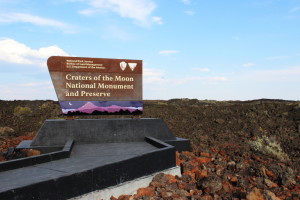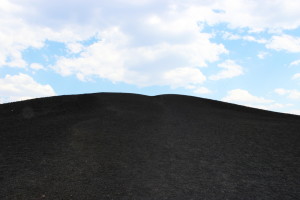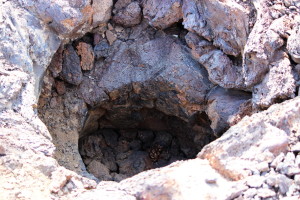 If you are traveling in south central Idaho, Craters of the Moon National Monument is definitely a stop that you’ll want to consider. This park houses a huge area of fairly recent (between 15,000 and 2,000 years ago) volcanic activity. It’s kind of like visiting another planet 🙂
If you are traveling in south central Idaho, Craters of the Moon National Monument is definitely a stop that you’ll want to consider. This park houses a huge area of fairly recent (between 15,000 and 2,000 years ago) volcanic activity. It’s kind of like visiting another planet 🙂
If you are short on time, take the driving tour and walk a couple of the short trails (North Crater Lava Flow, Devils Orchard, Spatter Cones, and Snow Cone Trail) and then drive through the rest of the park, checking out the informative signs. You’ll be amazed at the scenery!
 If you have more time, take some time on the longer trails. In particular, the view from the top of the Inferno Cone is stunning and will give you a nice look at the Great Rift where all this volcanic activity took place. You’ll also see other volcanic features in the distance as you look over the Snake River plain, including a “shield volcano” off in the far distance to the east. It’s definitely worth the steep hike if you want a great view. And you’ll be able to say that you stood on top of a cinder cone!
If you have more time, take some time on the longer trails. In particular, the view from the top of the Inferno Cone is stunning and will give you a nice look at the Great Rift where all this volcanic activity took place. You’ll also see other volcanic features in the distance as you look over the Snake River plain, including a “shield volcano” off in the far distance to the east. It’s definitely worth the steep hike if you want a great view. And you’ll be able to say that you stood on top of a cinder cone!
 The Tree Molds trail will give you some great examples of impressions left when trees were surrounded by lava, burnt, and the mold of where they were left intact as the trees turned to ash and disappeared. You can even see imprints left by the bark of trees that fell over horizontal on top of the soft lava and made some very distinct impressions.
The Tree Molds trail will give you some great examples of impressions left when trees were surrounded by lava, burnt, and the mold of where they were left intact as the trees turned to ash and disappeared. You can even see imprints left by the bark of trees that fell over horizontal on top of the soft lava and made some very distinct impressions.
The Cave Trails take you to a number of caves that are lava tubes, where the top of the flowing lava crusted over, but the lava underneath kept flowing, leaving a tube behind. Note that there are currently (2013) restrictions on entering the caves, due to concern about protecting the bats that live in these caves. A permit is required, and if you have been in any cave or mine since 2005, you’ll need to be able to tell the ranger that you are not wearing or carrying anything that you took into those caves. And that means anything: shoes, clothes, phone, camera, socks.
They are concerned about you carrying the spores of the fungal disease called white-nose syndrome into these caves. This disease has killed more then 5,000,000 bats since 2005. This information is on the National Park Service’s website for this monument, but it’s not immediately obvious. See the details here. If you are lucky enough to be able to explore the caves, make sure to bring flashlights, good shoes, and water with you.
There are other trails available in the park and if you go on all them you’ll see a wide variety of volcanic features, including different types of lava (paehoehoe and aa), cinder cones, spatter cones, craters, tree molds, different types of volcanic bombs, lava rivers, paehoehoe ropes, squeeze ups, pressure ridges, and much more. You’ll see more volcanic features than you thought possible!
Here’s a Flickr Slideshow from our visit. Hit the full screen icon in the lower right for the best picture views.
Other information about Craters of the Moon National Monument
Map:
Have any questions about Craters of the Moon National Monument? Ask below and we’ll do our best to get you the answers!
Or If you’ve visited the Craters of the Moon, what was your favorite part?
